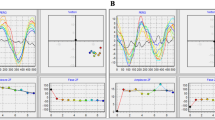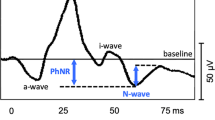Abstract
Purpose
To investigate within-test variability of the steady-state PERG (SS-PERG).
Methods
SS-PERGs were recorded in response to black–white horizontal gratings (1.6 cycles/deg, 98% contrast, 15.63 reversals/s, LED display, 25 deg square field, 800 cd/sqm mean luminance) using skin electrodes. PERG and noise (± reference) signals were averaged over 1024 epochs (~ 2.2 min) and Fourier analyzed to retrieve SS-PERG amplitude and phase. SS-PERGs were split into 16 partial averages (samples) of 64 epochs each, and corresponding amplitudes and phases combined in polar coordinates to assess their dispersion (within-test variability). To assess time-dependent variability, samples were clustered in four successive time segments of ~ 33 s each. Amplitude adaptation was defined as amplitude difference between initial and final clusters, and PERG phase adaptation as the corresponding phase difference. To determine the dynamic range of SS-PERG adaptation, recording was performed in normal controls of different age (n = 32) and patients with different severity of optic nerve dysfunction (early manifest glaucoma, EMG, n = 7; non-arteritic ischemic optic neuropathy, NAION, n = 5).
Results
Amplitude adaptation was largest in younger controls (amplitude adaptation ÷ noise, SNR = 9.5, 95% CI 13.1, 5.9) and progressively decreased with increasing age (older subjects, SNR = 5.5, 95% CI 9.2, 1.8) and presence of disease (EMG: SNR = 2.4, 95% CI 3.5, 1.4; NAION: SNR = 1.9, 95% CI 6.5,-2.2). In 11 young subjects, amplitude adaptation was repeatable (test–retest in two sessions a week apart; intraclass correlation coefficient = 0.59). Phase adaptation was not significantly different from zero in all groups.
Conclusions
SS-PERG adaptation accounts for a sizeable portion of the within-test variability. As it has robust SNR, sufficient test–retest variability, and is altered in disease, it may have physiological and clinical significance. This study suggests that SS-PERG protocols should include adaptation in addition to SS-PERG amplitude and phase/latency.




Similar content being viewed by others
References
Bach M, Brigell MG, Hawlina M, Holder GE, Johnson MA, McCulloch DL, Meigen T, Viswanathan S (2013) Iscev standard for clinical pattern electroretinography (PERG): 2012 update. Doc Ophthalmol 126:1–7
Holder GE (2001) Pattern electroretinography (PERG) and an integrated approach to visual pathway diagnosis. Prog Retin Eye Res 20:531–561
Zrenner E (1990) The physiological basis of the pattern electroretinogram. In: Osborne N, Chader G (eds) Progress in retinal research, vol 9. Pergamon Press, Oxford, pp 427–464
Ozdamar O, Toft-Nielsen J, Bohorquez J, Porciatti V (2014) Relationship between transient and steady-state pattern electroretinograms: theoretical and experimental assessment. Invest Ophthalmol Vis Sci 55:8560–8570
Porciatti V, Sorokac N, Buchser W (2005) Habituation of retinal ganglion cell activity in response to steady state pattern visual stimuli in normal subjects. Invest Ophthalmol Vis Sci 46:1296–1302
Porciatti V, Ventura LM (2009) Adaptive changes of inner retina function in response to sustained pattern stimulation. Vision Res 49:505–513
Fadda A, Di Renzo A, Parisi V, Stifano G, Balestrazzi E, Riva CE, Falsini B (2009) Lack of habituation in the light adapted flicker electroretinogram of normal subjects: a comparison with pattern electroretinogram. Clin Neurophysiol 120:1828–1834
Fadda A, Di Renzo A, Martelli F, Marangoni D, Batocchi AP, Giannini D, Parisi V, Falsini B (2013) Reduced habituation of the retinal ganglion cell response to sustained pattern stimulation in multiple sclerosis patients. Clin Neurophysiol 124:1652–1658
Porciatti V, Bosse B, Parekh PK, Shif OA, Feuer WJ, Ventura LM (2014) Adaptation of the steady-state PERG in early glaucoma. J Glaucoma 23:494–500
Monsalve P, Triolo G, Toft-Nielsen J, Bohorquez J, Henderson AD, Delgado R, Miskiel E, Ozdamar O, Feuer WJ, Porciatti V (2017) Next generation PERG method: expanding the response dynamic range and capturing response adaptation. Transl Vis Sci Technol 6:5
Gameiro G, Monsalve P, Golubev I, Ventura L, Porciatti V (2018) Neuro-vascular changes associated with the water drinking test. J Glaucoma 27(5):429–432
Schimmel H (1967) The (+) reference: accuracy of estimated mean components in average response studies. Science 157:92–94
Zele AJ, Feigl B, Kambhampati PK, Hathibelagal AR, Kremers J (2015) A method for estimating intrinsic noise in electroretinographic (ERG) signals. Doc Ophthalmol 131:85–94
Altman DG (1991) Practical statistics for medical research. Chapman and Hall, London
Bowd C, Tafreshi A, Vizzeri G, Zangwill LM, Sample PA, Weinreb RN (2009) Repeatability of pattern electroretinogram measurements using a new paradigm optimized for glaucoma detection. J Glaucoma 18:437–442
Porciatti V, Ventura LM (2004) Normative data for a user-friendly paradigm for pattern electroretinogram recording. Ophthalmology 111:161–168
Riva CE, Logean E, Falsini B (2005) Visually evoked hemodynamical response and assessment of neurovascular coupling in the optic nerve and retina. Prog Retin Eye Res 24:183–215
Demb JB (2008) Functional circuitry of visual adaptation in the retina. J Physiol 586:4377–4384
Demb JB, von Gersdorff H (2008) Ultraweak signals can cause synaptic depression and adaptation. Neuron 57:802–804
Funding
NIH-NEI RO1 EY019077 (VP), NIH center grant P30-EY014801 (VP), unrestricted grant to Bascom Palmer Eye Institute from Research to Prevent Blindness, Inc., provided support in the form of salary for Vittorio Porciatti, Maja Kostic (RO1 EY019077, RPB) and infrastructure (P30-EY014801). The sponsor had no role in the design or conduct of the study.
Author information
Authors and Affiliations
Corresponding author
Ethics declarations
Conflict of interest
All authors certify that they have no affiliations with or involvement in any organization or entity with any financial interest (such as honoraria; educational grants; participation in speakers’ bureaus; membership, employment, consultancies, stock ownership, or other equity interest; and expert testimony or patent-licensing arrangements), or non-financial interest (such as personal or professional relationships, affiliations, knowledge or beliefs) in the subject matter or materials discussed in this manuscript.
Statement of human rights
The study followed the tenets of the Declaration of Helsinki and was approved by the Institutional Review Board of the University of Miami.
Statement on the welfare of animals
This article does not contain any studies with animals performed by any of the authors.
Informed consent
Informed written consent was obtained from all subjects after the nature of the test and possible risks were explained in detail.
Rights and permissions
About this article
Cite this article
Monsalve, P., Ren, S., Triolo, G. et al. Steady-state PERG adaptation: a conspicuous component of response variability with clinical significance. Doc Ophthalmol 136, 157–164 (2018). https://doi.org/10.1007/s10633-018-9633-2
Received:
Accepted:
Published:
Issue Date:
DOI: https://doi.org/10.1007/s10633-018-9633-2




